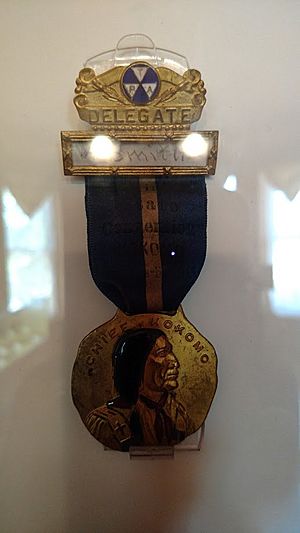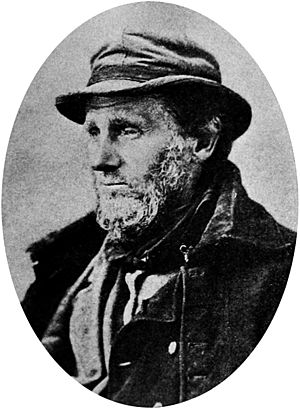Ma-Ko-Ko-Mo facts for kids

Kokomo, also known as Koh-Koh-Mah or Ma-Ko-Ko-Mo, was a Native American man from the Miami tribe. He lived in northern Indiana, likely in the early 1800s. The city of Kokomo, Indiana is named after him. David Foster, who founded the city, is often quoted saying, "It was the orneriest town on earth, so I named it after the orneriest Indian on earth—called it Kokomo." However, this story might not be true, and it's not clear if Foster even suggested the name.
The meaning of Kokomo's name is a mystery. Some old stories say Kokomo was a very strong and clever Miami chief, over seven feet tall. They say he led his tribe to success. Other stories, though, describe him as an ordinary person who was not a chief and had a bad reputation. His possible remains are buried in Pioneer Cemetery, where a monument honors him.
Contents
What Does the Name "Kokomo" Mean?

There are only two old papers that mention Miami men with names like Kokomo. The first time the name appears is in the Treaty at the Forks of the Wabash from 1834. A Miami man named "Co-come-wah" signed this treaty. The Miami people have always believed this person was Kokomo himself.
The only other record is from a trading post ledger on June 27, 1838. It says a person named "Koh Koh maw" bought flour.
No one knows for sure what the name Kokomo means. Kiilhsoohkwa, a Miami woman who lived from 1810 to 1915, spoke only the Miami language. She knew the name Kō-káhm-ah but said she didn't know what it meant. This suggests it might not even be a Miami word. Experts today agree that the meaning of the name Kokomo is still unknown.
Stories and Legends About Kokomo
Early Settlers' Tales

The city of Kokomo, Indiana, is named after Kokomo. But we don't know who first suggested the name or why. A popular story says that David Foster, the city's founder, once called it "the orneriest town on earth." He then said he named it after "the orneriest Indian on earth—called it Kokomo." This story is probably just a legend.
Many traditional stories say Kokomo was a great Miami chief in north-central Indiana. They describe him as very large and incredibly strong. He used his strength and cleverness to protect his people. He also helped them gain a large area for hunting. This version of the story says Kokomo was the "last of the fighting chiefs."
However, some other stories from early settlers tell a different tale. They say Kokomo was not a chief at all. Instead, they describe him as someone who caused trouble. One story from the Miami people in Peru says Kokomo was once part of their tribe. But he was a troublemaker. This story says he eventually took some people, mostly women, and started his own village by the Wildcat Creek.
An old history book from 1883 mentions that Chief Ma-Ko-Ko-Mo had three brothers who were also Miami chiefs. Their names were Shock-O-Mo (meaning 'poplar tree'), Me-Shin-Go-Me-Sia (meaning 'burr oak'), and Shap-Pan-Do-Si-A (meaning 'sugar tree'). It's not clear how much power each brother had. Chief Ma-Ko-Ko-Mo owned a log cabin in Howard County. David Foster took over this cabin in 1842 and built a trading post there. Foster traded with the Native American people in the area for many years.
Harrison Stewart's Story
In the early 1920s, a man named Harrison Stewart shared many details about Kokomo and David Foster. Stewart had moved to Kokomo in 1846 when he was ten years old. He had known David Foster personally.
Stewart said that Kokomo was a Miami chief who was very large and strong. He lived west of Muncie. Stewart claimed that Kokomo "brought riches and happiness to the Miami tribe" by gaining great hunting lands. According to Stewart, Foster never met Kokomo. He only heard stories about him from the Miami people who visited his trading post. Stewart also said that Foster believed the name Kokomo meant "he-bear" in the Miami language. Stewart stated that near the end of his life, Kokomo led hunting and fishing trips. These trips were to the area where the city of Kokomo was later built. Stewart said Kokomo died during one of these trips.
Stewart also shared a story David Foster told him before Foster died in 1877. Foster said that during the building of a sawmill, some Native American bones and tools were found. A doctor named Corydon Richmond looked at the bones. He thought they belonged to a "giant more than seven feet tall." The grave also had brass kettles and stone tools. Foster thought this meant the burial was very old. According to Stewart, when Foster heard this, he excitedly shouted, "Chief Kokomo! Chief Kokomo!" The bones believed to be Kokomo's were later moved to Kokomo's Pioneer Cemetery. A monument there marks the spot where his remains are said to be.
Historical Reenactment
Every mid-September, the Koh-Koh-Mah & Foster Living History Encampment holds a reenactment. It is located ten miles west of Kokomo. This event brings to life the times of Chief Ma-Ko-Ko-Mo.

